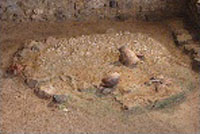| |
|

You are here :
Naxos >
Island Tour
> Sights >
Grotta
Grotta Naxos

The first inhabitants of Naxos considered being Thracians that dominated two
hundred years in the island. Later, came the Kares. They came from Asia Minor
having as their leader Naxos who gave his name to the island.
Archeological finds we have from the end of the 4th millennium B.C. The 3rd
millennium B.C., Naxos presents a big population to the west of the island. At
Panormos were found earnests of their civilization. In the
town of Naxos was
found a developed built-up-area with square houses and tiled roofs.

More finds there are in relation to the cemeteries of the region. Many graves
are masterpieces of art and date back to the 3rd millennium B.C.
There were found also earthen and marble vessels and marble statuettes of the
prehistoric era.
After the end of the Cycladic civilization flourishes to the same place the
marble material. Afterwards, about the 2nd millennium B.C. when it is developed
the Mycenaean civilization, falls the Cycladic. When in 1400 B.C. Crete retires,
Naxos helps to the spreading of the Mycenaean civilization to the East.

Naxos' population is transferred to the northwest in the main Greece. So, it is
created the town of Grotta about at 1000 B.C.
The 7th century B.C., it was created a society with rich people who lived, up on
the hill where today is the Castle of Chora. The people had been living from
agriculture, cattle, fishery and commerce. At 734 B.C. gives its fleet to
Chalkida for sending settlers to the West and in return gives its name to one
from the new towns. So, it arises Naxos, in Sicily. Many battles took place
against the island around and particularly, against Paros. At one of them, it
was killed the great poet of Paros, Arhilohos.
The worship in the religious centre of Delos affected Naxos. The old buildings
and the most important offerings in Delos, come from Naxos. The municipality of
Naxos dedicates valuable monuments to Apollo of Delos, as the Sphinx. The marble
is a plentiful material in Naxos and it is extracted in Delos for the large
labours. For the final smoothing of these labours it is used the
emery,
principal product of Naxos.
In Naxos we find male and feminine nude statues as: Artemis of the National
museum (about 650 B.C.), the marble Apollo in Delos, the huge lions in Delos as
also the two Kouros in Melanes and Dionysus in Apolonas with length of 10 metres.
The most important building in the sacred island is the house of the Naxos'
people.
|

